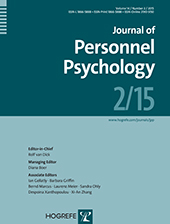Work–Life Imbalance as a Moderator in the Relationship Between Resources and Work Engagement
Abstract
This study examines the interplay between (a) job resources, (b) personal resources (organizational-based self-esteem, self-efficacy), and personality traits (conscientiousness, extraversion, and emotional stability), (c) a specific job demand (work–life imbalance), and (d) work engagement, in line with the alternative JD-R model proposed by Bakker (2011). Data was collected from 223 Romanian employees. Results show that work–life imbalance (WLI) undermines the positive relationship between self-efficacy and work engagement. In a three-way Job resources × Personal resources × Job demands interaction, self-efficacy and job resources had a positive relationship with work engagement when work–life imbalance was low. Also, in a three-way Job resources × Personality × Job demands interaction, the association between emotional stability and job resources was positive when work–life imbalance was low.
References
(1991). Multiple regression: Testing and interpreting interactions. Newbury Park, CA: Sage.
(2011). An evidence-based model of work engagement. Current Directions in Psychological Science, 20, 265–269.
(2010). The role of personality in the JD-R model. A study of Australian academic staff. Career Development International, 15, 622–636.
(2007). Job resources boost work engagement, particularly when job demands are high. Journal of Educational Psychology, 99, 274–284.
(2010). Where to go from here: Integration and future research on work engagement. Work engagement: A handbook of essential theory, and research (pp. 182–185). New York, NY: Psychology Press.
(2013). Weekly work engagement and flourishing: The role of hindrance and challenge job demands. Journal of Vocational Behavior, 83, 397–409.
(1997). Self-efficacy: The exercise of control. New York, NY: Freeman.
(1970). Back-translation for cross-cultural research. Journal of Cross-Cultural Psychology, 1, 185–216.
(2000). An empirical examination of self-reported work stress among US managers. Journal of Applied Psychology, 85, 65–74.
(2006). Stressors, resources, and strain at work: A longitudinal test of the triple-match principle. Journal of Applied Psychology, 91, 1359–1374.
(2011). The job demands-resources model: Challenges for future research. SA Journal of Industrial Psychology/SA Tydskrif vir Bedryfsielkunde, 37, 1–9.
(2001). The job demands-resources model of burnout. Journal of Applied Psychology, 86, 499–512.
. (2012). Fifth European working conditions survey. Luxemburg: Publications Office of the European Union.
(2007). Personality and the occupational stressor-strain relationship: The role of the Big Five. Journal of Occupational Health Psychology, 12, 20–33.
(1985). Sources of conflict between work and family roles. Academy of Management Review, 10, 76–88.
(2010). A meta-analysis of work engagement: Relationships with burnout, demands, resources and consequences. In A. B. BakkerM. P. LeiterEds., Work engagement: A handbook of essential theory and research (pp. 102–117). New York, NY: Psychology Press.
(2005). How dentists cope with their job demands and stay engaged: The moderating role of job resources. European Journal of Oral Sciences, 113, 479–487.
(2003). Resource loss, resource gain, and emotional outcomes among inner city women. Journal of Personality and Social Psychology, 84, 632–643.
(2011). The job demands-resources model: An analysis of additive and joint effects of demands and resources. Journal of Vocational Behavior, 79, 181–190.
(2011). Personality and job engagement. Journal of Personnel Psychology, 10, 177–181.
(2009). Burnout and engagement: A comparative analysis using the Big Five personality dimensions. International Journal of Hospitality Management, 28, 96–104.
(2009). State or trait: Effects of state optimism on job-related outcomes. Journal of Organizational Behavior, 30, 209–231.
(2005). A meta-analytic test of the challenge stressor-hindrance stressor framework: An explanation for inconsistent relationships among stressors and performance. Academy of Management Journal, 48, 764–775.
(2003). Work-home interference among newspaper managers: Its relationship with burnout and engagement. Anxiety, Stress, & Coping, 16, 195–211.
(2000). The 3 M Model of motivation and personality: Theory and empirical applications to consumer behavior. Boston, MA: Kluwer Academic.
(2003). Making sense of factor analysis. Thousand Oaks, CA: Sage.
(1989). Organizational-based self-esteem: Construct definition, measurement, and validation. Academy of Management Journal, 32, 622–648.
(2007). Differential challenge stressor-hindrance stressor relationships with job attitudes, turnover intentions, turnover and withdrawal behavior: A meta-analysis. Journal of Applied Psychology, 92, 438–454.
(2003). Common method biases in behavioral research: A critical review of the literature and recommended remedies. Journal of Applied Psychology, 88, 879–903.
(2010). Gain spirals of resources and work engagement. In A. B. BakkerM. P. LeiterEds., Work engagement: A handbook of essential theory and research (pp. 118–131). New York, NY: Psychology Press.
(2012). The self-concept in organizational psychology: Clarifying and differentiating the constructs. In G. P. HodgkinsonJ. K. FordEds., International review of industrial and organizational psychology (pp. 1–38). New York, NY: Wiley.
(2006). The measurement of work engagement with a short questionnaire. A cross-national study. Educational and Psychological Measurement, 66, 701–716.
(1995). Generalized self-efficacy scale. In J. WeinmanS. WrightM. JohnstonEds., Measures in health psychology: A user’s portfolio. Causal and control beliefs (pp. 35–37). Windsor, UK: NFER-NELSON.
(2002). Specific relationships between psychosocial job conditions and job related stress: A three-level analytic approach. Work and Stress, 16, 207–228.
(2007). The role of personal resources in the job demands-resources model. International Journal of Stress Management, 14, 121–141.



